Turning the tide on HIV in South Africa
25 June 2014 | Story by Newsroom
Dramatic advances in mother-to-child transmission and treatment that can safely reduce TB incidence are among recent successes that are helping in the fight against HIV.
South Africa has one of the highest rates of HIV in the world, and HIV prevalence continues to rise every year; nevertheless, the health services, supported by researchers, have had some outstanding successes in containing the disease.
Even the annual rise in prevalence, as reported recently by the Human Sciences Research Council (HSRC), hides a good-news story: the enormous success of the antiretroviral treatment (ART) programme means that people with HIV are living longer, which increases the total number of those living with HIV.
The number of people newly infected with HIV is decreasing. We have come a long way since the dark days of HIV denial, when nearly 750 people died from AIDS every day (as recounted by Edwin Cameron in his recent memoir, Justice). Currently, there are just over 2.0 million adults in South Africa on free treatment, according to the HSRC '“ the biggest ART programme in the world '“ and UNAIDS reported that there were 100 000 fewer AIDS-related deaths in 2011 than in 2005.
Life expectancy
In fact, modern ART is so effective, that we may be getting to a point where the reduction in life expectancy for those with HIV may be relatively small. Research led by Dr Leigh Johnson, an epidemiologist and actuary at the University of Cape Town (UCT), used statistical models based on local treatment outcome data to predict that HIV-positive adults in South Africa can have a near-normal life expectancy, provided they start ART before advanced immune suppression (specifically, before their CD4 count drops below 200 cells/µl). The implication for the lives of HIV-infected South Africans (and their mortgages and life insurance) are profound.
Mother to child transmission
One of the greatest achievements has been in preventing mother-to-child transmission (MTCT) of HIV. Without intervention, up to 30% of babies born of HIV-infected women would carry the disease themselves. Yet in 2012, the latest year for which we have figures, the rate was down to 2.7%.
"It's a dramatic achievement," says UCT Public Health specialist Dr Mary-Ann Davies: "A quiet miracle." So successful has it been, that we can now start to talk realistically about eliminating HIV in children. The remaining cases are so few that they are looked at individually: "Every single transmission is a representation that the system has failed," says Davies; the challenge is to identify where the system failed and then find ways to address that. This is the subject of her current research, funded by the National Institutes of Health (NIH).
The extraordinary success of the prevention of MTCT programme is the result of a number of factors. Firstly, it has been a priority programme: saving babies is clearly a moral imperative. Also, it's an achievable, short-term intervention, which can be realised with limited investment. Integrating the programme into antenatal care has had a big impact, in which antenatal facilities promote testing and provide treatment.
Lastly, there has been an effective focus on the pragmatic science of implementation, both at UCT and in the country at large. For instance, another project, led by Associate Professor Landon Myer, investigates how we can retain people in care after pregnancy. "This is very important research and we're well placed to do it at UCT," says Davies, "because it needs to be driven by local investigators. The science of it, what drugs to use, may be driven by research conducted elsewhere, but once you know the technicalities, it needs to be driven by someone who knows the context and can work with local stakeholders such as the Department of Health."
Eliminating those remaining cases of HIV transmission from mother to child is a tough challenge, however. We know from the research literature that the programme is already reaching the majority of pregnant women '“ those who want to be tested and are easily recruited. We now need to find ways to identify and bring into care those that are harder to reach '“ for example, mothers who are very young, drug dependent or sex workers '“ the patients who traditionally fall out of the healthcare system. Another difficult group is women who become infected during pregnancy, and who are therefore less easy to detect. The guidelines suggest testing women twice during pregnancy, then once during delivery and again while breastfeeding. However, once the women have had several negative results, it is difficult to motivate both them and the healthworkers to keep testing.
Protecting against TB
Another good news story for patients with HIV is a reduced likelihood of contracting tuberculosis (TB). HIV has driven a dramatic resurgence of the TB epidemic, and TB is the biggest cause of morbidity and mortality in people infected with HIV in Africa.
A trial of isoniazid preventive therapy (IPT) plus antiretroviral therapy (ART) to prevent tuberculosis has shown safety and efficacy in patients with HIV, say researchers of a study published in The Lancet. Both IPT and ART protect against TB in HIV-infected people, but it was not known if the two would give additive protection or could be safely combined.
The research team was spearheaded by Dr Molebogeng Rangaka and included clinic staff working for Médecins Sans Frontières (MSF) and the Western Cape Provincial Government, with supervision from Professor Gary Maartens and Professor Robert Wilkinson at UCT. They conducted a trial of IPT in people on ART to prevent TB at Khayelitsha Site B Clinic in Cape Town. The addition of IPT was found to be safe and to reduce TB incidence by 37%.
"These findings will change clinical practice and contribute immensely to the reduction of the scourge of TB. It is one of the highlights of research in the faculty in recent times," says Professor Bongani Mayosi, head of Medicine at UCT and Groote Schuur Hospital.
Discussing the purpose of the study, Professor Maartens explains that it is well established that the risk of TB could also be reduced by IPT in HIV-infected people not on ART. However, ART also reduces the risk of TB. It was previously unknown whether isoniazid would give additional benefit and whether it was safe in patients on ART.
"Therefore we did a placebo-controlled, randomised trial, involving 1,329 participants on ART in Khayelitsha in a Provincial Department of Health clinic," he says.
The results showed that 12 months of isoniazid reduced the risk of TB significantly (by 37%) and was well-tolerated. Importantly, it showed that the benefit was not limited to people with positive tuberculin skin tests (TST) '“ all prior studies, which were done in people not on ART, showed that the benefit was only seen in people with positive TSTs.
Professor Maartens says that TB-preventive therapy with isoniazid in people with HIV has been under-utilised. Some reasons for this include: TST is difficult to do and the patient has to return after two or three days to read the result; follow-up and care of people not yet needing ART is challenging to set up. By contrast, adding isoniazid to patients already in care and receiving regular ART is very easy to implement '“ an additional advantage is that a TST does not have to be done. The findings of this study, which was funded by the Department of Health, MSF, Wellcome Trust and the European and Developing Countries Clinical Trials Partnership, have already resulted in modified policy by the National Department of Health.
A new vaccine?
The best news of all about HIV, of course, would be a vaccine. The discovery of how a woman in KwaZulu-Natal responded to her HIV infection by making antibodies may have provided researchers with clues about how to do this. The antibodies, called broadly neutralizing antibodies, are particularly potent because they can kill multiple strains of HIV from across the world. Researchers found and identified these antibodies in her blood and cloned them. The cloned antibodies were then used in a series of experiments in the laboratory to understand the developmental pathway followed by her immune system to make these potent HIV-neutralising antibodies. The large international research team, led by National Institute for Communicable Diseases and the Centre for the AIDS Programme of Research in South Africa (CAPRISA), included Professor Carolyn Williamson, and PhD student Daniel Sheward, both from UCT. The results, which were published in Nature, indicate a significant step in the future development of a potential vaccine for HIV.
Doria-Rose NA et al (2014) Developmental pathway for potent V1V2-directed HIV-neutralising antibodies. Nature 509, 55-62
Johnson LF et al (2013) Life expectancies of South African adults starting antiretroviral treatment: collaborative analysis of cohort studies. PLoS Medicine 10(4), e1001418 2013
Rangaka MX et al (2014) Isoniazid plus antiretroviral therapy to prevent tuberculosis: a randomized double-blind, placebo-controlled trial: Lancet 13(10), 825-827
 This work is licensed under a Creative Commons Attribution-NoDerivatives 4.0 International License.
This work is licensed under a Creative Commons Attribution-NoDerivatives 4.0 International License.
Please view the republishing articles page for more information.










